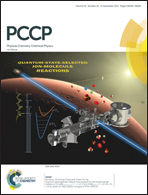Understanding the role of co-catalysts on silicon photocathodes using intensity modulated photocurrent spectroscopy†
Abstract
The addition of a co-catalyst onto the surface of a photocathode often greatly enhances the harvested photovoltage of the system. However, the true nature of how the catalyst improves the onset potential remains poorly understood. As a result, how to best utilize effective co-catalysts is still a limiting factor in achieving high performance earth abundant photoelectrochemical hydrogen evolution. Using intensity modulated photocurrent spectroscopy (IMPS), we have probed charge behaviors at the photoelectrode co-catalyst interface. We find that Pt drastically reduces charge recombination at the semiconductor liquid interface (SCLI). Further studies reveal that the onset potentials can be improved either by accelerating the reaction kinetics or reducing the recombination at the SCLI. The knowledge permits us to understand how earth abundant HER catalysts, such as CoP, behave at the SCLI. It is found that CoP is more effective at accelerating the reaction kinetics than reducing recombination.



 Please wait while we load your content...
Please wait while we load your content...